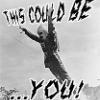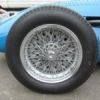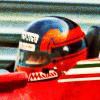That's right, Collombin - I neglected to mention that because it's not really part of Duncan's collection.

Here now's the real star of the team's stable of cars, the beautiful and extremely effective Konstant Hot Special Sprint car. Built in 1962 by Phillips for his new boss, it was extremely successful, almost from the start - it failed to qualify for its first two shows, though. Ernie McCoy, Don Branson and A. J. Foyt drove it before McCluskey came aboard, and both Branson and Foyt took a win and a pole position apiece with it. McCluskey first drove the car at Eldora on July 29, took pole position, won the fast heat and led the main event from flag to flag - wow! He won again on the Winchester asphalt and the Reading Fairgrounds dirt track, then went to California for a couple of end-of-season programmes at Ascot, winning them both to secure the Owners Championship for Homeyer over Harlan Fike, the owner of back-to-back National Sprint Car Champion Parnelli Jones. McCluskey and the Konstant Hot Special hit the floor running in 1963, and were simply uncatchable - details of that campaign can be observed in the 1963 thread mentioned and linked to above. That, however, is not the end of the story - not by a long way!
Homeyer's 11th hour decision to dissolve his team in early 1964 left a few people wrong footed - everybody was seemingly fully occupied preparing for the upcoming season, and nobody seems to have fancied adding another car to his team at such short notice, so the back-to-back championships winning car was picked up by a 28-year-old Gokart manufacturer from Ohio, who fancied having a go at Sprint car racing. Whether Mickey Rupp had any experience in racing outside of karting is still open for debate, but he did appear for the traditional Eastern Opener at Reading end of March, qualified easily in a field of more than two dozen nationally known Sprint car stars, and finished ninth in the main event - just like that! Better still, he made the main event 16 times in twenty tries, finished in the points 15 times, including a second place at Allentown in September (ahead of Foyt, Branson, Marshman, Rutherford, Andretti and Johncock…!!) and ran in the top ten in points all year, finally finishing ninth! All of which opened the door for him to compete in a few Indy car races, including the 1965 '500', which he survived to finish an excellent sixth, and even before summer was over, he'd sold his car, packed up his things and gone back to Ohio to continue manufacturing Gokarts, mini bikes and the like until he tired of it, went to Canada to manufacture snowmobiles, thence to Florida to build boats - a true racing maverick!
Next to own the former Konstant Hot Special was Clarence Anderson of Xenia, a suburb of Dayton in Western Ohio, just a couple of hours down the road from Rupp's place in Mansfield/OH. Anderson, known as "Mutt" in racing circles, had been a motorcycle and car racer in the thirties, then an owner and mechanic for drivers like Ev Saylor, Tony Willman, Rex Mays, Jimmy Davies, Troy Ruttman, Mike Nazaruk, Andy Linden or Eddie Sachs before leaving the sport to work as a butcher in the family business. The lure of racing was too strong, however, and the prospect of owning such a potent car too exciting. When the 1965 USAC Sprint car trail stopped at Eldora/OH for round two of the National Championship, Anderson rolled out his car with a surprise driver, West coast star Bob Hogle, who'd never driven in the area before, but finished an impressive sixth. For the next race at New Bremen/OH, Anderson hired IMCA star Carl Williams of Missouri, another completely unknown, who went on to finish second, and after another runner-up finish on the banked asphalt track at Winchester a few weeks later, Mutt was approached by Roger McCluskey, who'd been out of a regular Sprint car ride since breaking an arm the same day that Rupp had debuted at Reading in early 1964! Roger and Mutt quickly agreed terms, and McCluskey was back in the hot seat of his championship ride in 1963. A succession of excellent finishes (but no wins!) saw the combination climb up to fifth on drivers points and fourth in owners points by year end - good, but not good enough!
The 1966 season turned out to be a virtual replay of the 1963 campaign - if anything, McCluskey and the old Konstant Hot Special were even more dominant than before: Eight wins, six seconds, four thirds and three fourths in 26 races left Roger streets ahead of Mario Andretti and Bobby Unser in points, and earned Mutt his first ever title in racing - for the car, it was the third in five years! It was too good to last, though: after a couple of poor results early in 1967, McCluskey quit the team to concentrate on Indy car racing henceforth, and was replaced by the likes of Bobby Unser, A. J. Foyt, Johnny Rutherford, Bruce Walkup, Billy Vukovich and Larry Dickson - all capable drivers, but they all moved on after just a few races, and by 1968 Anderson had become a part-time racer, his heart was no longer in it. When he was approached by fellow Dayton townsman George (II) Walther, who was looking for a car for his boat racing sons to enter auto racing, Mutt was willing to sell. David "Salt" Walther raced the old car for two seasons on his way to a substantial, if troubled career in Indy cars and beyond, while George (III) "Skip" Walther tried the car at least once, but failed to qualify. I don't know what happened next to the car, but I suspect it was raced on for years in local competition.
Edited by Michael Ferner, 05 April 2020 - 19:32.




















